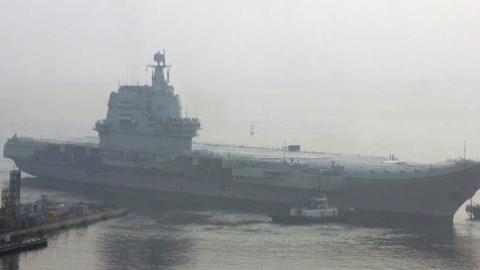According to satellite imagery taken on 23 October, the People’s Liberation Army’s Type-003 aircraft carrier is nearing completion. Between 18 September and 23 October, several gaps in the carrier’s deck were sealed. As the gaps were in place to allow the installation of major internal components like the carrier’s propulsion, the fact they are closed suggests that the carrier’s internals are nearly fully installed.
Several components remain uninstalled, namely the carrier’s two starboard elevators, radars, and point-defense weapons. Additionally, its two electronic-launch catapults require more testing. Nevertheless, the Type-003 carrier likely will be launched around February 2022, reaching the PLA Navy later that year.
China's carrier construction indicates two elements of its broader strategy that the U.S. must recognize.
First, while the PLA Navy’s next carrier will be more sophisticated than the Type-003, Chinese construction timelines are clearly much more rapid than their American counterparts. The U.S. should not expect a long delay between the Type-003’s deployment and the Type-004’s. The two yards most likely to construct the Type-004 are the Jiangnan Shipyard, which is producing the Type-003, and the Dalian Shipyard, which produced China’s ski-jump carrier Shandong.
Available dock information indicates that Dalian Shipyard would be a more reasonable location: Jiangnan's dry docks have a capacity of 80,000 tons, compared to Dalian's 300,000-ton floating dry dock, while the Type-004 is planned to displace 100,000-plus tons. However, modifications are possible at Jiangnan, and the yard has experience with supercarrier construction that Dalian lacks.
Nevertheless, both are owned by the same parent company, China State Shipbuilding Corporation. The Party's vested interest in efficient construction would enable labor transfer between yards. Lead ships are always difficult; hence the Type-004 will encounter predictable development issues. But China's yards are generally more efficient than their American counterparts, given the Party-State's support and the reduced safety and unionization concerns of these yards. The PLA has between four and six years to construct the Type-003, a warship not much smaller than the Type-004, albeit with conventional propulsion. Therefore, it is entirely conceivable for China to accelerate Type-004 construction, perhaps fielding a second carrier in late 2024.
Second, China’s dual-use approach to its shipyards bolsters its defense-industrial base, critical in a great-power conflict. The Jiangnan Shipyard produces surface combatants for the PLA Navy, including its Type-052C/D destroyers and its Type-055 stealth cruisers. However, it is also employed for civilian construction. The same satellite imagery used to assess the Type-003 carrier provided evidence of slowed warship construction at Jiangnan and accelerated merchant ship production, primarily for foreign buyers.
This dual-use policy allows China to maintain the human capital necessary for warship construction without exclusively awarding shipyards military contracts. American naval shipyards are afforded no such support. Huntington Ingalls’ Pascagoula, MI shipyard built the most recent American-flagged deep-water cruise ship in 2005, while U.S.-produced tankers and merchant ships are few and far between. While China has maintained its maritime-industrial labor force, the U.S. has eroded. A poor defense industrial base will make accelerating construction, repairing, and refitting ships during a high-end conflict extremely difficult. And given the physical infrastructure required, it will be exceptionally difficult to expand American capacity once a conflict has begun.
A key signal for the future will be the precise construction pace on the Type-004. China may encounter a window of opportunity in 2024. Current Taiwanese president, and DPP chair Tsai Ing-wen, cannot seek a third term. Tsai has been a defining force in Taiwanese politics since her first term as DPP chair in 2008. Although it appears she will remain chair through the elections, her successor in the Party remains unclear. Moreover, an impending four-question referendum could transform Taiwan's political climate: if Tsai's Party loses, the DPP will be hamstrung for the remainder of her term, increasing internal political competition. China has meddled in Taiwan’s elections and manipulated its news media in the past, directly supporting apparently sympathetic candidates. And China almost certainly has a robust intelligence network on the island that will conduct sabotage operations when strategically necessary. Thus, a close-run election could provide the PLA an opportunity to escalate against Taiwan.
In turn, Taiwan’s next president will take office on 20 May 2024, during the final third of the U.S. presidential primary process in what will be a hotly contested, divisive, bitter electoral contest irrespective of any party's candidate. If Mr. Biden seeks another term, his attention will be focused internally, even without a primary challenger. And if not, he will be tasked with mediating between Kamala Harris, who despite her current position is increasingly disliked within the Democratic Party, and alternative candidates from every faction of the left, including Millennial Instagram celebrity Alexandria Ocasio-Cortez – who, one must note, could be Mr. Biden's vice-presidential nominee given Ms. Harris' unpopularity. The U.S. policy class will be focused overwhelmingly on another round of partisan combat for approximately half a year.
Depending upon other international events, this gap could be an excellent opportunity for a Chinese strike against Taiwan.
However, China may deem it imprudent to move against the U.S. at this point. The purpose of China's carrier force is to provide it with the capabilities needed to push beyond the First Island Chain, either beyond the Miyako Strait and Bashi Channel into the Philippine Sea or more ambitiously from the Malacca or Lombok Straits into the Indian Ocean. Without a power-projection force, the PLA may take Taiwan but face Japanese, American, and Australian resistance in the Philippine Sea and, even more worrying for the CCP, be subjected to a far blockade against Malacca and Lombok. A drawn-out conflict will trigger a global economic downturn of similar scale to the Great Depression. Yet while this would damage the U.S. and its allies, China’s authoritarian, opaque system is far more at risk: hence the CCP’s continuous emphasis on economic growth to placate its urban population.
While two CATOBAR carriers would not give the PLA the capability to project power into the Indian Ocean, it would make offensive operations in the Philippine Sea far more viable, especially if the PLA can monopolize the South China Sea within a conflict's first week and turn to pressure the Philippines and Japan. Thus, accelerated Type-004 construction and deployment would indicate at minimum an identified window of opportunity for the CCP. In turn, it would also indicate a fear that its future window of opportunity – at some point between 2027 and 2032, when China's carrier program will be more advanced, its anti-submarine capabilities more robust, and its partnerships with Iran, Pakistan, and Russia more explicit – may be slipping away.
The underlying premise of American strategy remains military transformation, the conviction that a nexus of high-technology capabilities will provide the U.S. military a decisive advantage over its Chinese and Russian adversaries. But transformation takes time, hence, for example, the Navy's Divest to Invest scheme will reduce the large surface combatant fleet to free up money for smaller warships and unmanned surface vessels. The unasked question still stands: what if China does not respect our languid timetable? Sino-American antagonism may burst into confrontation far sooner than we think.
Read in RealClear Defense


















